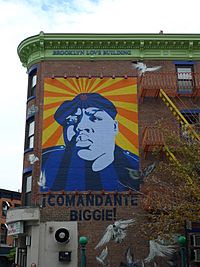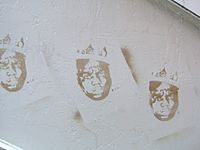The Notorious B.I.G. facts for kids
Quick facts for kids
The Notorious B.I.G.
|
|
|---|---|

Wallace in 1995
|
|
| Born |
Christopher George Latore Wallace
May 21, 1972 New York City, U.S.
|
| Died | March 9, 1997 (aged 24) Los Angeles, California, U.S.
|
| Resting place | Cremated, ashes given to family members |
| Other names |
|
| Occupation |
|
| Years active | 1992–1997 |
| Spouse(s) | |
| Children | 2, including C. J. |
| Awards | Full list |
| Musical career | |
| Genres | |
| Labels |
|
| Associated acts |
|
Christopher George Latore Wallace (born May 21, 1972 – died March 9, 1997), known by his stage names the Notorious B.I.G., Biggie Smalls, or simply Biggie, was an American rapper and songwriter. He was a very important figure in East Coast hip hop music from New York City. Many people think he is one of the greatest rappers ever.
Biggie grew up in Brooklyn, New York City. In 1993, he signed with Sean "Puffy" Combs' new record label, Bad Boy Records. He became well-known by appearing on songs with other artists that year. His first album, Ready to Die, came out in 1994. It was loved by critics and included his famous songs "Juicy" and "Big Poppa". This album made him a central figure in East Coast hip hop. It also helped New York rap become popular again when West Coast hip hop was very big.
In 1995, Biggie won the Billboard Music Award for Rapper of the Year. The next year, he helped his group, Junior M.A.F.I.A., become successful. This group included his longtime friends, like Lil' Kim.
Sadly, on March 9, 1997, while visiting Los Angeles, Biggie was killed in a drive-by shooting. The person who did it has never been found. His second album, Life After Death, which was a double album, was released two weeks later. It went straight to number one on the Billboard 200 chart. It later earned a Diamond certification in the U.S., meaning it sold over 10 million copies.
Biggie has sold over 28 million copies of his music in the United States, including 21 million albums. Rolling Stone magazine called him the "greatest rapper that ever lived." Billboard also named him the greatest rapper of all time. In 2020, he was added to the Rock and Roll Hall of Fame.
Contents
Early Life and Beginnings
Christopher George Latore Wallace was born in Brooklyn, New York City, on May 21, 1972. He was the only child of parents who had moved from Jamaica. His mother, Voletta Wallace, was a preschool teacher. His father, Selwyn George Latore, was a welder and politician. Biggie's father left the family when he was two years old. His mother worked two jobs to raise him.
Biggie grew up at 226 St. James Place in Brooklyn's Clinton Hill. He was raised Catholic and was a great student at Queen of All Saints Middle School. He won many awards for his English studies. He was called "Big" because he was overweight by the age of 10.
As a teenager, he started rapping for fun on the streets. He performed with local groups called the Old Gold Brothers and the Techniques. His first stage name was MC CWest. He also learned about jazz music from a saxophonist named Donald Harrison, who lived nearby. Biggie later went to George Westinghouse Career and Technical Education High School in Downtown Brooklyn. Other famous rappers like Jay-Z and Busta Rhymes also went there. His mother said he was a good student. At age 17 in 1989, Biggie left high school early.
His Unique Musical Style
How Biggie Rapped
Biggie usually rapped in a deep voice. Rolling Stone magazine described it as a "thick, jaunty grumble." His voice became even deeper on his album Life After Death. Often, Sean "Puffy" Combs would add short sounds or words, called ad libs, to Biggie's songs.
Critics described his style as "cool, nasal, and filtered." He was very good at putting many rhymes close together, one after another. Time magazine said he could make "multi-syllabic rhymes sound smooth." Before starting a verse, Biggie sometimes made sounds like "uhhh" or "what" to warm up his voice.
Other rappers like Lateef and Fredro Starr said Biggie had "intense and complex flows." This means he had a very skillful and interesting way of delivering his rhymes. Big Daddy Kane noted that Biggie didn't need a huge vocabulary to impress listeners. He just put his words together in a clever way that worked very well.
Biggie was known for creating lyrics in his head instead of writing them down. This was similar to how Jay-Z worked. Sometimes, he would change his usual style. For example, on the song "Playa Hater," he sang in a slow, high voice called a falsetto. On "Notorious Thugs," a song with Bone Thugs-n-Harmony, he changed his style to match their fast rapping.
Biggie's Lasting Legacy
Biggie is seen as one of the greatest rappers of all time. AllMusic called him "the savior of East Coast hip-hop." In 2002, The Source magazine named him the greatest rapper ever. In 2003, when XXL magazine asked many hip hop artists to name their top five favorite MCs, Biggie was on more lists than anyone else. In 2006, MTV ranked him number 3 on their list of The Greatest MCs of All Time. They said he might be "the most skillful ever on the mic."
Editors at About.com ranked him number 3 on their list of the Top 50 MCs of Our Time (1987–2007). In 2012, The Source ranked him number 3 on their list of the Top 50 Lyrical Leaders of all time. Rolling Stone has called him the "greatest rapper that ever lived." In 2015, Billboard also named Biggie the greatest rapper of all time.
Biggie's lyrics have been used and quoted by many artists. These include Jay-Z, 50 Cent, Alicia Keys, Eminem, Lil Wayne, and Usher. At the 2005 MTV Video Music Awards, Puff Daddy and Snoop Dogg honored Biggie. They had an orchestra play while Biggie's vocals from "Juicy" and "Warning" played. The 2005 VH1 Hip Hop Honors show also featured a special tribute to Biggie.
Biggie had started a clothing line called Brooklyn Mint, which would make clothes for larger sizes. This project stopped after he passed away. In 2004, his managers Mark Pitts and Wayne Barrow relaunched the clothing line. They sold T-shirts with Biggie's picture on them. Some of the money from sales goes to the Christopher Wallace Foundation.
The Christopher Wallace Memorial Foundation holds an event each year called "B.I.G. Night Out." This event raises money for school equipment for children. For this special event, "B.I.G." also stands for "Books Instead of Guns."
There is a large mural, which is a painting on a wall, of Biggie in Brooklyn. It is on Fulton Street, not far from where he grew up. A fan asked to have the corner of Fulton Street and St. James Place renamed in his honor. Many local businesses supported this idea.
A big picture of Biggie is shown in the Netflix series Luke Cage. This is because he inspired the character of Cornell "Cottonmouth" Stokes in the show. In August 2020, Biggie's son, C.J., released a house remix of his father's popular song "Big Poppa".
A Netflix documentary called Biggie: I Got a Story to Tell was released in March 2021. Biggie's mother, Voletta Wallace, and Sean Combs helped produce it. The film focuses on Biggie's life before he became famous.
The Biopic Film
Notorious is a movie from 2009 about Biggie's life. The rapper Jamal Woolard played Biggie in the film. George Tillman Jr. directed the movie. Sean Combs, Biggie's former managers Wayne Barrow and Mark Pitts, and his mother Voletta Wallace were all producers for the film. The movie received mixed reviews and made over $44 million around the world.
Discography
- Studio albums
- Ready to Die (1994)
- Life After Death (1997)
- Collaboration album
- Conspiracy with Junior M.A.F.I.A. (1995)
- Posthumous collaboration album
- The King & I with Faith Evans (2017)
- Posthumous compilation albums
- Born Again (1999)
- Duets: The Final Chapter (2005)
Media Appearances
Filmography
- The Show (1995) as himself
- Rhyme & Reason (1997 documentary) as himself
- Biggie & Tupac (2002 documentary) archive footage
- Tupac Resurrection (2004 documentary) archive footage
- Notorious B.I.G. Bigger Than Life (2007 documentary) archive footage
- Notorious (2009) archive footage
- All Eyez on Me (2017) archive footage
- Quincy (2018 documentary) archive footage
- Biggie: The Life of Notorious B.I.G. (2017 documentary) archive footage
- Biggie: I Got a Story to Tell (2021 documentary) archive footage
- Transformers: Rise of the Beasts (2023) archive footage
Television appearances
- New York Undercover (1995) as himself
- Martin (1995) as himself
- Who Shot Biggie & Tupac? (2017) archive footage
- Unsolved (2018) archive footage
Awards and Nominations
| Award | Year of ceremony | Nominee/work | Category | Result |
|---|---|---|---|---|
| The Source Hip-Hop Music Awards | 1995 | The Notorious B.I.G. | New Artist of the Year, Solo | Won |
| The Notorious B.I.G. | Lyricist of the Year | Won | ||
| The Notorious B.I.G. | Live Performer of the Year | Won | ||
| Ready To Die | Album of the Year | Won | ||
| Billboard Music Awards | 1995 | The Notorious B.I.G. | Rap Artist of the Year | Won |
| "One More Chance/Stay with Me (Remix)" (with Faith Evans) | Rap Single of the Year | Won | ||
| 1997 | Life After Death | R&B Album | Won | |
| Grammy Awards | 1996 | "Big Poppa" | Best Rap Solo Performance | Nominated |
| 1998 | "Hypnotize" | Best Rap Solo Performance | Nominated | |
| "Mo Money Mo Problems" (with Mase and Puff Daddy) | Best Rap Performance by a Duo or Group | Nominated | ||
| Life After Death | Best Rap Album | Nominated | ||
| MTV Video Music Awards | 1997 | "Hypnotize" | Best Rap Video | Won |
| 1998 | "Mo Money Mo Problems" (with Mase and Puff Daddy) | Best Rap Video | Nominated | |
| Soul Train Music Awards | 1996 | "One More Chance/Stay With Me (Remix)" (with Faith Evans) | R&B/Soul or Rap Song of the Year | Won |
| 1998 | Life After Death | Best R&B/Soul Album - Male | Won | |
| Life After Death | R&B/Soul or Rap Album of the Year | Nominated | ||
| "Mo Money Mo Problems" (with Mase and Puff Daddy) | Best R&B/Soul or Rap Music Video | Nominated | ||
| Black Reel Awards | 2004 | "Runnin' (Dying to Live)" (with Tupac Shakur) | Best Original or Adapted Song | Nominated |
| ASCAP Rhythm & Soul Music Awards | 2005 | "Runnin' (Dying to Live)" (with Tupac Shakur) | Top Soundtrack Song of the Year | Won |
| 2017 | The Notorious B.I.G. | ASCAP Founders Award | Won | |
| 2020 | "Sicko Mode" | Winning Rap and R&B/Hip-Hop Songs | Won | |
| Rock and Roll Hall of Fame | 2020 | The Notorious B.I.G. | Performers | Won |
See also
 In Spanish: The Notorious B.I.G. para niños
In Spanish: The Notorious B.I.G. para niños



